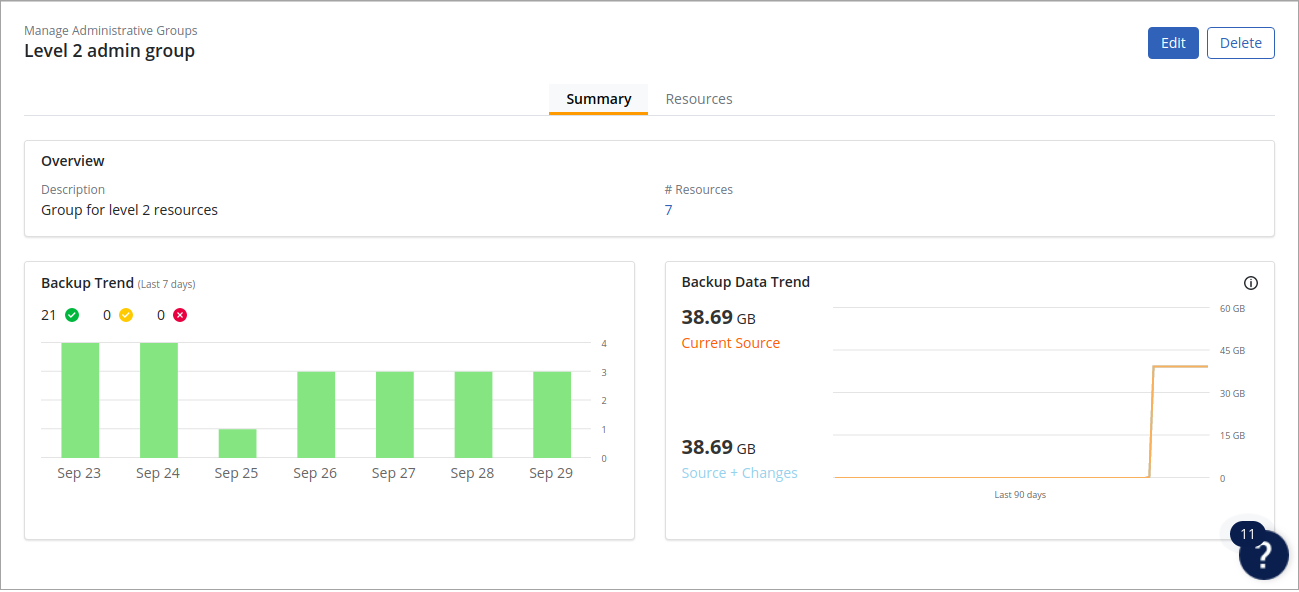Heads up!
We've transitioned to a new documentation portal to serve you better. Access the latest content by clicking here.
Overview
An administrative group is a logical categorization of the servers that share something in common. For example, servers located in one region can belong to one administrative group. Similarly, servers having the same operating system can belong to another administrative group.
An administrative group allows you to organize your servers for better management. To manage the servers under a group, you assign a group admin. It is mandatory that you create an administrative group and attach servers to it.
A cloud or an organization administrator can optionally create a group administrator. A group administrator can manage one or more administrative groups assigned by the cloud or organization administrator. A group administrator can perform the following group management tasks only for the assigned administrative groups:
View administrative groups
- Log in to Druva Cloud Platform Console.
- Click
 > Enterprise Workloads > Select the required organization from the All Organizations menu, and then click Manage > Administrative Groups.
> Enterprise Workloads > Select the required organization from the All Organizations menu, and then click Manage > Administrative Groups.
- The Manage Administrative Groups page displays a list of available administrative groups.
- You can click the administrative group for which you want to view details.
- The Summary tab of the administrative group details page displays the following fields:

| Field |
Description |
|
Description
|
The description for the administrative group.
|
|
# Resources
|
The number of servers associated with the administrative group.
|
|
Backup Trend
|
The Backup Trend section displays backup jobs for the last seven days with the following three statuses:
For the detailed explanation of each parameter, see Dashboards.
|
| Backup Data Trend |
The Backup Data section illustrates the following data for the last 90 days:
Source + Changes: The amount of backup data generated at the source. This includes the initial full backup and incremental data from all subsequent backups.
Current Source: The size of the data on the source server(s) at the time of the last backup.
|
The Resources tab of the administrative group details page displays the following fields:
| Field |
Description |
|
Name
|
The name of the resource.
|
|
Resource Type
|
The type of resources such as Physical Server, VMware VM, Hyper-V VM, NAS Share, SQL Availability Group, Phoenix Store, and SQL Standalone Instance.
|
Create a new administrative group
- Log in to Druva Cloud Platform Console.
- Click
 > Enterprise Workloads > Select the required organization from the All Organizations menu, and then click Manage > Administrative Groups.
> Enterprise Workloads > Select the required organization from the All Organizations menu, and then click Manage > Administrative Groups.
- Click New Group.

- Enter the name and description of the group and click Save.
- The administrative group created now appears on the Manage Administrative Groups page.
Update administrative group details
Change administrative group from server listing
You can change the administrative group associated with a configured server.
Procedure
- Log in to the Management Console.
- Select the workload from the Protect menu. Note that if the All Organizations menu is enabled, you have to first select an organization and then select the workload.
- In the Registered Servers page, select the server(s) whose administrative group you want to change.
- Click More options, and then click Change Admin Group.
- The Change Administrative Group dialog box is displayed. The Change Administrative Group to drop-down list displays the names of all the administrative groups. However, if only one administrative group exists, you cannot change the administrative group associated with your File server.

- From the Change Administrative Group to drop-down list, select the administrative group, and click Save. The File server is now attached to the new administrative group.
Note: For single-server configuration, the Change Administrative Group to drop-down list does not display the administrator group that is associated with the File server.
Delete an administrative group
You can delete an administrative group at any time. However, If a resource is mapped to the group you cannot delete the group.
- Log in to Druva Cloud Platform Console.
- Click
 > Enterprise Workloads > Select the required organization from the All Organizations menu, and then click Manage > Administrative Groups.
> Enterprise Workloads > Select the required organization from the All Organizations menu, and then click Manage > Administrative Groups.
- The Manage Administrative Groups page displays a list of available administrative groups.
- To delete an administrative group you can:
- Select an administrative group and click Delete.
OR
- Click on the administrative group and on the Administrative group details page, click Delete.
- The Delete Administrative Group dialog opens. Edit the name and/or description.
- Click Save.
 Business
Business  Enterprise
Enterprise  Elite
Elite  Business
Business  Enterprise
Enterprise  Elite
Elite 




